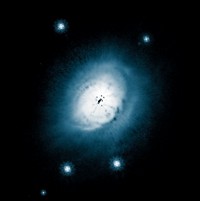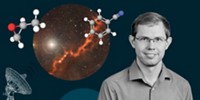Advertisement
Grab your lab coat. Let's get started
Welcome!
Welcome!
Create an account below to get 6 C&EN articles per month, receive newsletters and more - all free.
It seems this is your first time logging in online. Please enter the following information to continue.
As an ACS member you automatically get access to this site. All we need is few more details to create your reading experience.
Not you? Sign in with a different account.
Not you? Sign in with a different account.
ERROR 1
ERROR 1
ERROR 2
ERROR 2
ERROR 2
ERROR 2
ERROR 2
Password and Confirm password must match.
If you have an ACS member number, please enter it here so we can link this account to your membership. (optional)
ERROR 2
ACS values your privacy. By submitting your information, you are gaining access to C&EN and subscribing to our weekly newsletter. We use the information you provide to make your reading experience better, and we will never sell your data to third party members.
Astrochemistry
Movers And Shakers
Harvard scientist uses astrochemistry to understand the birth of planets
Karin Öberg combines lab experiments, theoretical models, and telescope observations to investigate the reactions that give rise to solar systems
by Raleigh McElvery, special to C&EN
September 11, 2021
| A version of this story appeared in
Volume 99, Issue 33

The universe is 13.8 billion years old—and like many things that have been around for a while, it’s collected lots of dust. And just one of these dust particles could seed an entire planet.
After a star is born, it becomes surrounded by a rotating disk of gas and silicate dust particles. Here, in the nursery of a new solar system, the temperature is just a few degrees above absolute zero. The surfaces of the swirling dust grains become coated with ice and serve as miniature laboratories in which the chemical building blocks of nascent planets are concocted. Over millions of years, the dust grains collide and stick together, creating larger and larger bodies and eventually growing into planets.
Astrochemists like Karin Öberg aim to understand how those infinitesimal icy grains seed solar systems beyond our own—and perhaps contribute to life on other worlds. Her lab at Harvard University combines theoretical modeling with bench experiments and far-reaching observations from the Atacama Large Millimeter/submillimeter Array (ALMA). She spoke with Raleigh McElvery about the origins of chemicals in outer space. This interview was edited for length and clarity.
Vitals
▸ Current position: Professor of astronomy, Harvard University
▸ Hometown: Born in Nyköping but grew up in Karlskrona, both in Sweden
▸ Education: BS, chemistry, California Institute of Technology, 2005; PhD, astrophysics, Leiden University, 2009; Hubble Postdoctoral Fellow, Harvard-Smithsonian Center for Astrophysics, 2009–12
▸ Favorite molecule: “I have a special affinity for acetonitrile because nitriles have been implicated in origins-of-life chemistry. It remains a mystery how this nitrile is formed, and I like mysteries.”
Fun fact about ice chemistry: Water ice is the third-most-common molecular species in the galaxy, behind molecular hydrogen and carbon monoxide.
▸ Favorite celestial body: “Comets are the most interesting solar system bodies, because they are basically failed planets that never grew large enough. They contain the building blocks of life, including water and nitriles.”
▸ Hobbies: “I’m in a constant war with squirrels over my kale patch.”
▸ Best part of the job: Guiding students to become scientists
What’s your personal origin story?
During my sophomore year of college, I realized I was much better at chemistry than physics but much more interested in astrophysics than physical chemistry. I had this dilemma: Do I choose what I’m good at or what I’m really interested in? I discovered a field that allowed me to combine the two, astrochemistry. The field goes back decades, but it has recently expanded quite substantially. That had a lot to do with the ALMA telescope, which is very good at studying the distribution of molecules in space.
How does the chemical soup surrounding a young star give rise to planets?
It’s only 10 K in the dusty clouds that stars and planets form from. That imposes some limitations on the chemical reactions that can occur. For instance, you’re not going to have stable molecules that are energetic enough to overcome the entrance barrier to a chemical reaction. Instead, you get reactions that include atoms, radicals, and ions.
It’s also quite difficult to get rid of the energy that goes into forming a chemical bond in the gas phase. Whenever you’re forming a bond, say, between oxygen and hydrogen, you go into an energetically lower state. That means you have energy you need to get rid of. And if you don’t get rid of it quickly, it will go back into breaking the bond and the atoms will fly apart. On Earth, that is not a problem because a lot of chemistry happens in solutions, which absorb excess energy. In space, the surface of a dust grain serves a similar purpose, allowing oxygen and hydrogen to form water—a molecule that’s near and dear to any earthling.
Organic molecules—including methane, methanol, and ammonia—are formed on these grain surfaces as well. Because it’s so cold in space, the water freezes and coats the grains, trapping the organic molecules. Now you have a feedstock of potential reactants—the organic molecules turn into radicals through interactions with UV photons, electrons, or atoms, allowing for the next generation of chemistry to occur.
If you just warm up the ice a tiny bit, let’s say to 30 K, the radicals start moving around and react to form bigger molecules such as ethanol, diethyl ether, acetonitrile, and ethyl cyanide. The ice that’s coating the grains helps everything stick together so they can eventually form planets, which could maybe even support life.
How do you synthesize lab experiments, modeling, and telescope observations to probe chemical evolution?
Telescopes help us see what molecules are present in the dust and gas disks where planets are forming. But these observations are very limited because we can only get snapshots. Also, it’s relatively easy to see the gas but much harder to see the icy grains.
That’s where the models come in. They are networks of chemical reactions that fill the gaps between observations and expand what kinds of molecules we can predict will end up on planets. To get those reaction networks, you need to do calculations or lab experiments to determine how molecules will react with one another under different conditions.
How do you use this three-pronged approach to investigate your favorite prebiotic chemicals?
Right now, my favorite chemicals are nitriles—molecules that have a carbon-nitrogen triple bond. They are suspected to have played a big role in the origins of life here on Earth. We have seen them in space, but we often don’t know how they form, which makes it difficult to predict how likely they are to show up on other planets. My lab is currently doing experiments trying to figure out plausible chemical pathways that could form nitriles in icy environments.
We also have a big project with ALMA data, trying to map the chemical inventory of the disks around five stars that are similar to our young sun. One of the things we are looking at is where these nitriles are found. We also recently got a proposal approved to look at these same five disks using instruments onboard the James Webb Space Telescope [expected to launch Dec. 18, 2021]. ALMA shines when we’re looking at regions of the disks that are farther away from the young star. But it’s not so good at looking at the part of a disk closer to the star where terrestrial planets would form. That’s where James Webb will shine. By combining the two, we’re hoping to develop a holistic view of how nitriles and other molecules are distributed across the planet-forming zones in these disks.
Whenever we get a new telescope, we tend to see lots of things we didn’t expect. James Webb will allow us to get a complete inventory of the icy grains in these disks for the first time. That’s going to be eye opening. We’ll find out if our predictive models are correct—or whether there are surprises in there.

Raleigh McElvery is a freelance writer based in Cambridge, Massachusetts. A version of this story first appeared in ACS Central Science: cenm.ag/oberg.





Join the conversation
Contact the reporter
Submit a Letter to the Editor for publication
Engage with us on Twitter